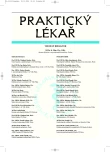Contemporary approaches to osteosynthesis of child fractures
Authors:
P. Havránek; T. Pešl
Authors‘ workplace:
Přednosta: prof. MUDr. Petr Havránek, CSc., FEBPS
; Fakultní Thomayerova nemocnice, Praha
; 3. lékařská fakulta
; Klinika dětské chirurgie a traumatologie
; Univerzita Karlova v Praze
Published in:
Prakt. Lék. 2008; 88(12): 700-706
Category:
Various Specialization
Overview
First of all it is necessary to state that children’s fractures are predominantly not treated operatively but by orthopaedic methods, i.e. by closed reduction and plaster cast fixation. In our department 86.4 % of paediatric fractures are treated non-operatively, only 13.6 % are operated on. The German speaking European countries are most active in indicating the surgical treatment of child fractures. The U.K. and North American countries are traditionally conservative. However, nowadays a rapid increase in the number of indications for surgical approaches to skeletal trauma in children can be seen. It is influenced by several factors: better diagnostics of skeletal trauma (digital X-ray, X-ray amplifiers, CT with digital reconstruction, MRI, etc.), the possibility of a minimally invasive surgical procedure with C-arm X-ray amplifier navigation. One further reason can be seen in the revolutionary development of osteosynthetic implants. Not only the quality of the materials, (titanium wires, nails, screws and plates, bioabsorbable implants) but also the possibility of a minimally invasive procedure (intramedullary nails, cannulated screws, locked plates) are responsible for the increased number of operations. Contemporary surgical treatment of child fractures in strictly limited indications can ensure the treatment success without follow-up operations, a shortened hospital stay and recovery period of the injured child.
Key words:
child fractures, osteosynthesis, physis, elastic stable intramedullary mailing, minimal invasive osteosynthesis .
Sources
1. Bartl, V., Melichar, I., Gál, P. Naše zkušenosti s elastickou stabilní intramedulární osteosyntézou u dětí. Rozhl. chir., 1996, 75, s. 486-488.
2. Blount, W.P. Fractures in children. Baltimore: Williams & Wilkins, 1955.
3. Dietz, H-G., Schmittenbecher, P.P., Slongo, T., Wilkins, K.E. (eds.) Elastic stable intramedullary nailing (ESIN) in children. AO manual of fracture management. New York: Thieme, 2006.
4. Garg, N.K., Ballal, M.S., Malek, I.A., et al. Use of elastic stable intramedullary nailing for treating unstable forearm fractures in children. J. Trauma 2008, 65, p. 109-115.
5. Gordon, J.E., Gregush, R.V., Schoenecker, P.L., et al. Complications after titanium elastic nailing of pediatric tibial fractures. J. Pediatr. Orthop. 2007, 27, p. 442-446.
6. Havránek, P. Dětské zlomeniny. Praha: Corvus, 1991, s. 23-26
7. Havránek, P. Osteosyntéza dětských zlomenin vstřebatelnými tyčinkami. Acta Chir. orthop. Traum. čech. 1994, 61, s. 234-238.
8.Havránek, P. Perkutánní osteosyntéza dětských zlomenin. Rozhl. chir., 1997, 76, s. 359-363.
9. Havránek, P., Hájková, H., Motl, V., Povýšil, C. Fibrin glue osteosynthesis of epiphyseal injuries. Int. surg. 1985, 70, p. 257-261.
10. Havránek, P., Pešl, T. Možnosti využití techniky nitrodřeňového stabilního elastického hřebování (ESIN) dětských zlomenin v netypických indikacích. Acta Chir. orthop. Traum. čech., 2002, 69, p. 73-78.
11. Hedequist, D., Bishop, J., Hresko, T. Locking plate fixation for pediatric femur fractures. J. Pediatr. Orthop., 2008, 28, p. 6-9.
12. Jamil, W., Allami, M., Choudhury, M.Z., et al. Do orthopaedic surgeons need a policy on the removal of metalwork? A descriptive national survey of practicing surgeons in the United Kingdom. Injury 2008, 39, p. 362-367.
13. Métaizeau, J.P. (ed.) L’ostéosynthèse chez l’enfant? Techniques et indications. Rév. chir. orthop., 1983, 69, p.. 495-511.
14. Müller, M.E., Allgöwer, M., Willenegger, H. Manual der Osteosynthese. Berlin Heidelberg: Springer, 1977.
15. Parent, S., Wedemeyer, M., Mahar, A.T., et al. Displaced olecranon fractures in children: a biomechanical analysis of fixation methods. J. Pediatr. Orthop. 2008, 28, p. 147-151.
16. Pleva, L., Richter, V., Krejčí, M., Posolda, T. Elastická nitrodřeňová osteosyntéza u dětí. Zpr. úraz. chir. 1994, 2, s. 17-20.
17. Shrivastava, A.K., Mehlman, C.T., Wall, E.J., Do, T.T. Elastic stable intramedullary nailing of tibial shaft fractures in children. J. Pediatr. Orthop. 2008, 28, p. 152-158.
18. Schmittenbecher, P.P., Fitze, G., Gödeke, J., et al. Delayed healing of forearm shaft fractures in children after intramedullary nailing. J. Pediatr. Orthop. 2008, 28, p. 303-306.
19. Swenson, A.L. Treatment of supracondylar fractures of the humerus by Kirschner-wire fixation. J. Bone Joint Surg. Am. 1948, 30, p. 993-997.
20. Vander Have, K., Herrera, J., Kohen, R., Karunakar, M. The use of locked plating in skeletally immature patiens. Am. Acad. Orthop. Surg. 2008, 16, p. 436-441.
21. Walsh, S.J., Boyle, M.J., Morganti, V. Large osteochondral fractures of the lateral femoral condyle in the adolescent: outcome of bioabsorbable pin fixation. J. Bone Joint Surg. Am. 2008, 90, p. 1473-1478.
Labels
General practitioner for children and adolescents General practitioner for adultsArticle was published in
General Practitioner

2008 Issue 12
- Memantine Eases Daily Life for Patients and Caregivers
- Metamizole vs. Tramadol in Postoperative Analgesia
- Metamizole at a Glance and in Practice – Effective Non-Opioid Analgesic for All Ages
- Memantine in Dementia Therapy – Current Findings and Possible Future Applications
- What Effect Can Be Expected from Limosilactobacillus reuteri in Mucositis and Peri-Implantitis?
Most read in this issue
- Idiopathic thrombocytopenic purpura
- Percutaneous endoscopic gastrostomy – experience of one PEG centre in years 2002–2008
- Contemporary approaches to osteosynthesis of child fractures
- Sigmoid volvulus – untypical condition in childhood
